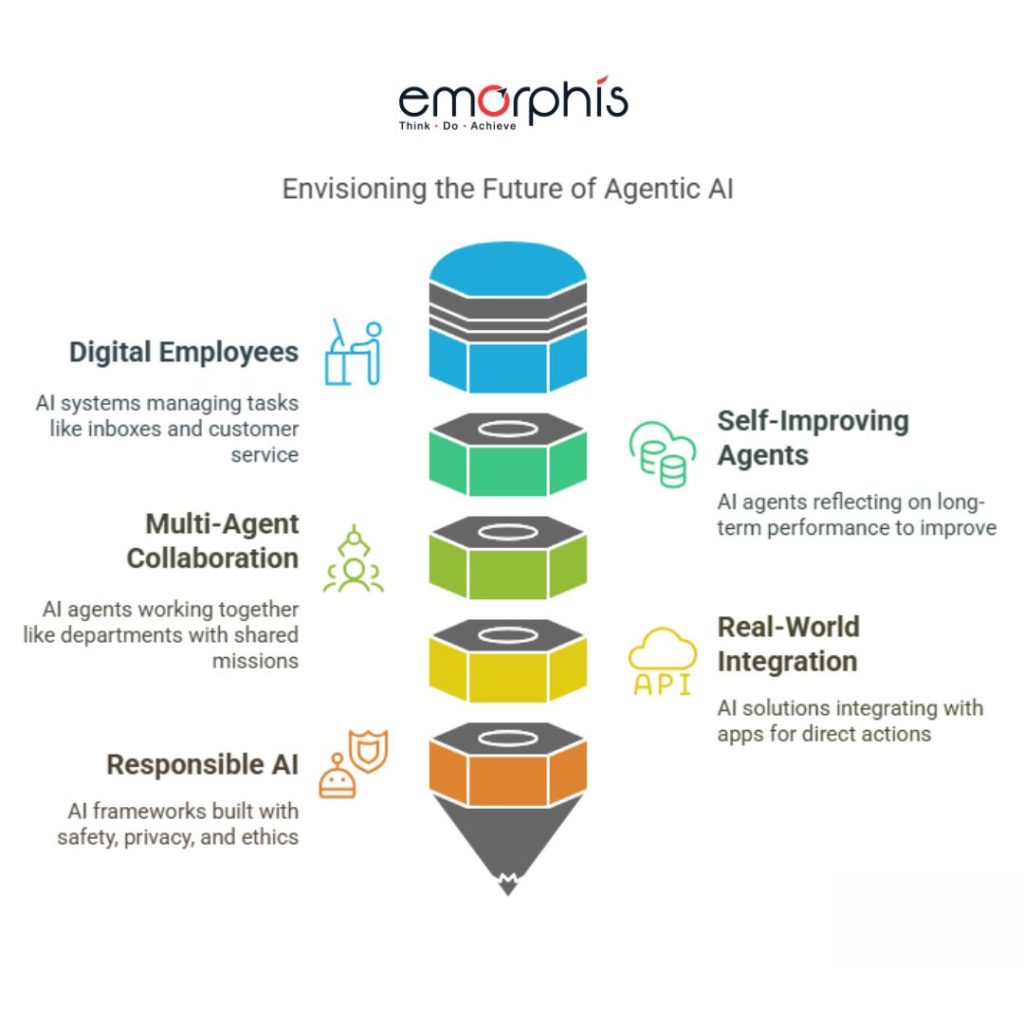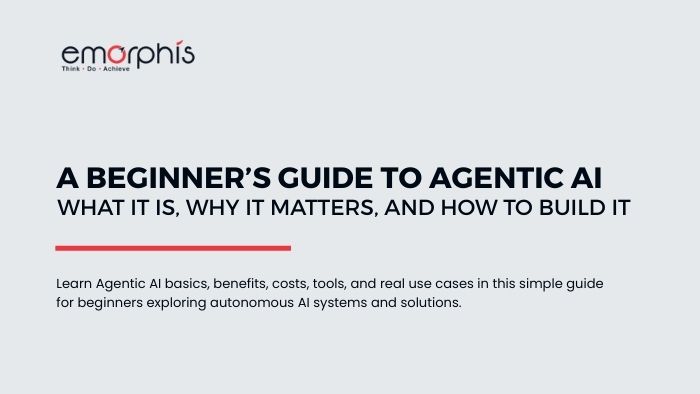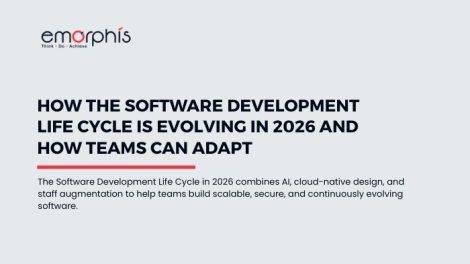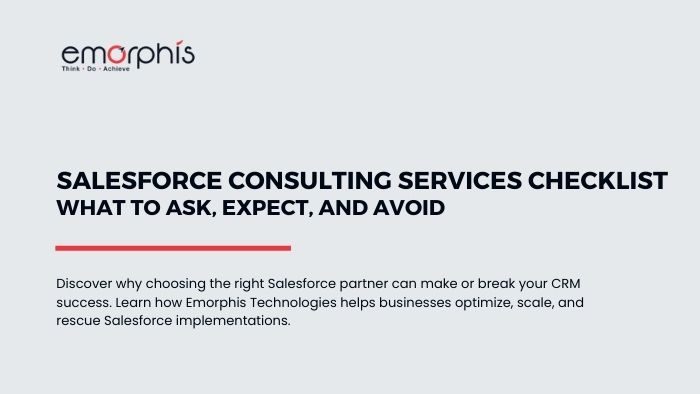Artificial intelligence is evolving beyond simple chatbots and assistants in today’s fast-paced digital world. The latest breakthrough? Agentic AI is a powerful, autonomous form of AI that acts like a smart teammate instead of a basic tool.
According to a report by Mordor Intelligence, the Agentic AI market is projected to grow from USD 7.28 billion in 2025 to USD 41.32 billion by 2030, driven by its ability to operate autonomously in dynamic environments.

North America is emerging as a key hub for agentic AI adoption, with industries like healthcare, manufacturing, and IT leading the charge.
According to Mordor Intelligence, organizations are increasingly using agentic AI to enhance workflows, automate tasks, and improve customer service.
In the U.S., 10% of large enterprises already use the technology, with 82% planning adoption within three years. Canadian businesses are also seeing a rise in AI integration, with 37% of large firms already on board. Government support, advanced research, and early success stories like Atlantic Health System and NASA’s Jet Propulsion Lab highlight the region’s strong momentum, though challenges like trust and skills gaps persist.

If you’re new to this concept, don’t worry. This guide will walk you through what Agentic AI is, how it works, why it’s useful, how much it costs to build, the best Agentic AI frameworks, and where it’s heading in the future.
Let’s dive in.
What is Agentic AI?
Agentic AI refers to artificial intelligence that can act autonomously to achieve specific goals. Think of it as an intelligent agent that can reason, plan, and take action, not just answer questions or follow one-off commands.
What Makes It “Agentic”?
Unlike traditional AI, which waits for your input, Agentic AI can:
- Take initiative based on a goal or instruction
- Break complex tasks into smaller steps
- Use tools or APIs to gather and process data
- Reflect on progress and change its approach when needed
For example, instead of just answering “What’s the weather in Paris?”, an AI solution could plan your whole trip, check the weather, compare hotels, book your flight, and send you an itinerary, all in one go.
This makes AI systems ideal for automating workflows, handling research tasks, managing emails, or even writing reports.

Key Concepts Behind Agentic AI
To understand AI better, let’s break down its building blocks:
1. Agent
The “agent” is the brain behind the operation. It’s the intelligent unit that understands what it needs to do and figures out how to do it — all while being goal-oriented.
2. Memory
Just like humans, Agentic AI needs memory to function properly. This could be:
- Short-term memory (what it just read or done)
- Long-term memory (user preferences, past tasks)
Memory allows the AI system to learn and adapt over time.
3. Planning
Planning is a crucial feature. Instead of acting randomly, AI creates a logical plan by breaking down big goals into smaller steps, often using reasoning techniques like Chain of Thought or ReAct (Reason + Act).
4. Tool Use
Agentic AI frameworks often let the agent access tools like:
- Web browsers
- Calculators
- APIs
- File readers
This gives it the ability to go beyond language and take meaningful action.
5. Reflection
Some AI solutions can reflect on their performance. For example, if a research agent gets irrelevant results, it can go back, revise its plan, and try again. This makes it more reliable and effective over time.
Explore how generative AI is transforming industries.
Tools and Frameworks for Agentic AI Development
Building an agentic AI system doesn’t require reinventing the wheel. Several tools and AI frameworks make development much easier.
Popular Agentic AI Frameworks:
| Framework | What It Does |
|---|---|
| LangChain | Build multi-step agents with memory, tool use, and reasoning. Great for Python and JavaScript devs. |
| AutoGPT | An experimental, fully autonomous agent that can research and complete goals on its own. |
| CrewAI | A team-based approach: assign roles (e.g., Researcher, Writer, Reviewer) to multiple agents. |
| OpenAI Function Calling | Let GPT models use tools like search engines, databases, or custom APIs. |
| LlamaIndex | Great for agents that need to work with structured data, documents, or PDFs. |
With these AI frameworks, you can build an agent that not only understands text but also takes actions like pulling real-time data, creating files, or updating databases.
Cost of Building an Agentic AI System
Now you may be wondering, “How much does it cost to build an agentic AI solution?”
The answer: It depends on how advanced you want to go. Here’s a general breakdown:
| Type of Agentic AI Solution | Estimated Cost |
|---|---|
| Simple Agent (no memory, single task) | $0 – $500 |
| Intermediate Agent (with tools + logic) | $2,000 – $10,000 |
| Enterprise Agentic AI System (multi-agent, secure, scalable) | $20,000 – $100,000+ |
Cost Components:
- LLM APIs (OpenAI, Claude, etc.): $20–$1,000/month depending on usage
- Vector databases (Pinecone, Weaviate): Free to $500/month
- Developer time: $50–$200/hour
- Infrastructure (hosting, logging, etc.): Based on cloud usage
You can reduce costs by using open-source LLMs and running them locally. But remember, the more autonomy and tools you add, the more complex (and expensive) the agentic AI solution becomes.
Benefits of Using Agentic AI
So why use Agentic AI instead of traditional automation or assistants? Here are the key benefits:
1. Saves Time
Agentic AI systems can perform long, complex tasks faster than a human, like writing a report, planning a trip, or analyzing data.
2. Works 24/7
Once built, your AI solution can run continuously without breaks, making it perfect for support bots, content creation, or monitoring tasks.
3. Scalable
You can deploy multiple agents or multi-role agents without increasing headcount. That means more work done for less cost.
4. Learns and Adapts
Thanks to memory and reflection, an agentic AI system can get better over time, learning from past mistakes and adapting to new situations.
5. Works Across Industries
From healthcare to e-commerce, AI frameworks can be customized for any domain.

Learn how to boost your business with a Custom AI Chatbot solution.
Real-World Use Cases of Agentic AI Solutions
Now let’s explore how agentic AI solutions are being used in different industries:
Healthcare
In healthcare, agentic AI systems help improve patient care by reducing manual tasks and making data more accessible to professionals.
- Patient follow-up bots: Automatically check in with patients after treatment or surgery to remind them about medication, upcoming appointments, and symptoms to watch out for.
- Clinical trial matchmakers: Match patients with the most suitable clinical trials by analyzing their health data and cross-referencing eligibility requirements.
- Research summarizers for doctors: Use agentic AI frameworks to read and summarize lengthy medical research papers, giving doctors quick insights in seconds.
Business Operations
Businesses are adopting agentic AI solutions to streamline internal processes, reduce repetitive tasks, and assist with strategic decision-making.
- Proposal writers: Automatically generate business proposals and sales documents using internal data, past templates, and market trends.
- Automated meeting schedulers: Find the best time for meetings by analyzing team calendars and sending out invites without back-and-forth emails.
- CRM task managers: Keep your customer relationship system updated by logging interactions, sending follow-ups, and setting reminders automatically.
Data & Analytics
Agentic AI systems are revolutionizing how organizations handle data, from processing to reporting and insights.
- Dashboard updaters: Continuously fetch real-time data from various sources and update BI dashboards like Tableau or Power BI without manual effort.
- Report generators: Create daily, weekly, or monthly performance summaries by pulling data from databases and formatting it into readable reports.
- SQL query builders: Let non-technical users ask questions, then convert them into SQL queries and run them against your data warehouse.
E-commerce
In e-commerce, agentic AI solutions are personalizing shopping and helping businesses optimize pricing, inventory, and customer engagement.
- Product comparators: Automatically compare items based on features, reviews, and pricing, then recommend the best choices to users.
- Shopping assistants: Act as virtual personal shoppers, answering questions, suggesting products, and guiding purchases via chat.
- Price tracking bots: Monitor competitor websites or marketplaces and notify store owners of changes or adjust prices in real-time.
Travel & Hospitality
The travel and hospitality industry is using AI frameworks to simplify planning and improve guest experiences.
- Trip planners: Organize full trips including flights, hotels, sightseeing, and dining options, based on user preferences and budget.
- Real-time booking agents: Search and book accommodations, transportation, and experiences instantly, adapting to changes in availability.
- Travel advisors that build full itineraries: Generate detailed, personalized travel plans that can update dynamically as circumstances change.
Education
Education is being transformed by agentic AI systems that support both learners and educators with adaptive and intelligent tools.
- AI tutors: Offer personalized lessons, explanations, and practice problems tailored to the student’s level and learning speed.
- Curriculum designers: Automatically create structured courses and learning modules based on academic goals or subject matter.
- Homework graders: Review and grade assignments, provide feedback, and even detect plagiarism or common learning gaps.
Across all these sectors, AI solutions are reshaping how tasks are done, making processes faster, smarter, and more scalable. With the right design, agentic AI systems can be adapted to almost any industry that benefits from automation, decision-making, and intelligent planning.
The Future of Agentic AI
We’re still in the early days of agentic AI, but the possibilities are growing fast. Here’s what the future might look like:
1. Digital Employees
AI systems will evolve into full digital workers — managing inboxes, handling customer service, and even running marketing campaigns.
2. Self-Improving Agents
Future agents will reflect not just on single tasks, but on long-term performance, improving themselves like real team members.
3. Multi-Agent Collaboration
Multiple agents will work together like departments: a planner, a researcher, a writer — each with a role and a shared mission.
4. Real-World Integration
AI solutions will tie into apps like Slack, Gmail, Google Sheets, and CRMs to take direct actions in real environments.
5. Responsible AI
With great power comes great responsibility — safety, privacy, and ethics will be built into AI frameworks from the ground up.

Beginner-Friendly Projects to Get Started
Want to try building one yourself? Here are some simple starter projects using agentic AI frameworks like LangChain:
| Project | Description |
|---|---|
| 📰 News Researcher | Gathers news and summarizes it into a daily digest. |
| 📅 Meeting Planner | Schedules meetings using your calendar and preferences. |
| 📧 Email Sorter | Categorizes emails as urgent, medium, or low priority. |
| 📈 Market Research Assistant | Finds the best products or services in a given category. |
| 📚 Study Companion | Answers questions, makes quizzes, and explains topics. |
These are great ways to experiment with AI without a big budget or complex setup.

Final Thoughts
Agentic AI is the next evolution of artificial intelligence, moving from static answers to autonomous actions. Whether you’re an entrepreneur, developer, or innovator, learning to build with agentic AI frameworks is a skill that can unlock endless opportunities.
By understanding how AI solutions work, where they’re useful, and how much they cost, you’re well on your way to being ahead of the curve.
And remember: Agentic AI isn’t just about building smarter bots. It’s about creating intelligent teammates ones that think, act, and grow with you.
Need help getting started with your first agentic AI project or choosing the right AI framework?







